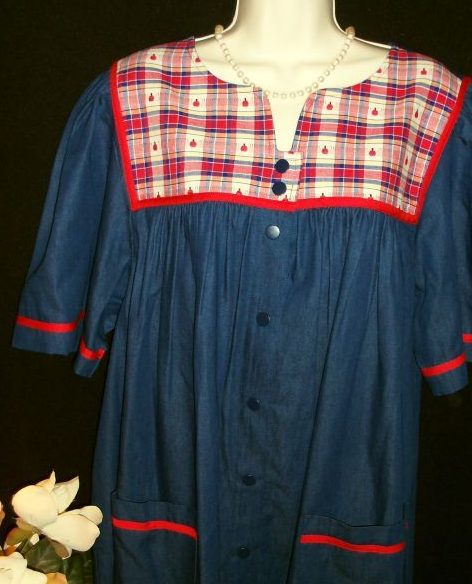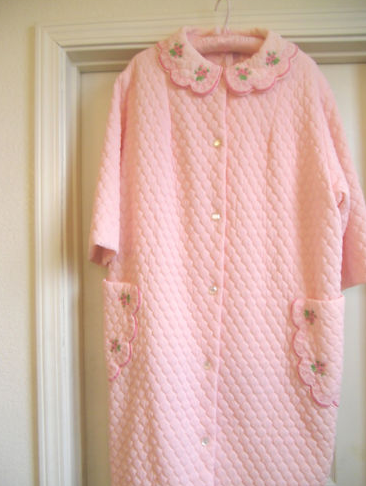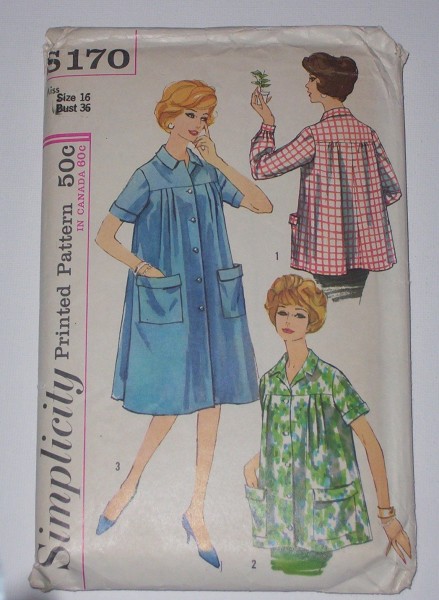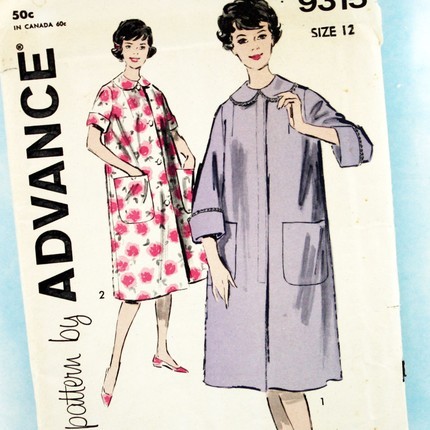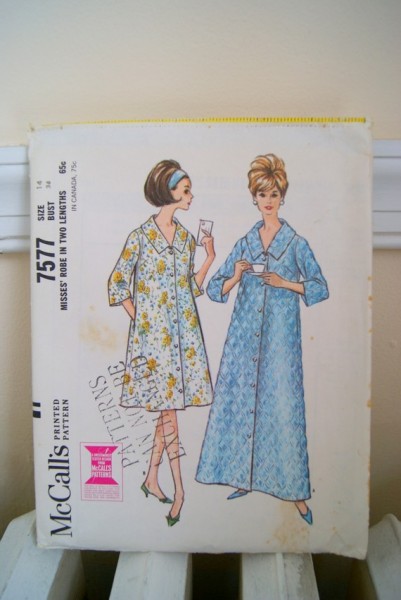“Think simple” as my old master used to say—
meaning reduce the whole of its parts into the simplest terms,
getting back to first principles.
-Frank Lloyd Wright
A few weeks ago I ran across this video for the koobli™: a “unisex cover-up garment designed to protect your clothing from life’s unpredictable spills and messes. Made from soft, supple, strong 100% micro polyester suede, koobli™ is lightweight and easy to slip on and pull off — use it to cover work outfits, suits, uniforms, gowns, etc. Tough enough for multiple wearings yet disposable when necessary, koobli™’s simple, sensible and functional design makes it a must-have for busy parents and caregivers.”
Watch the video. I’ll wait. (RSS and email readers may have to click through.)
Okeydoke. So, for the bargain price of $25 plus s&h, you too can have an adult smock.
OR…..
We could bring back the housecoat.
I suspect if you were born after 1980, you may not even remember the housecoat. When I was searching for housecoats on Old Man Google, I found that most people used the term interchangeably with bathrobe, and the two are not quite the same.
Now, my Great-Aunt Jean had two types of clothing she called a housecoat. There were the “light housecoats,” which were handsewn cotton overshirts, with mother-of-pearl snap buttons and big poufy pockets with elastic at the top (so you could load them up with stuff but the pocket top would remain closed). You would wear these over your clothes when cleaning or cooking to protect whatever you were wearing underneath, and if the doorbell were to ring? The snap buttons pulled open in a, well, snap, and voila! You were presentable for company.
This one is remarkably similar to the one that was “mine” when I went to visit and is for sale on ebay:
The other housecoat, the “heavy housecoats,” were long and quilted and warm. They zippered all the way from the neck to the hem. Some were a thick sateen-like fabric, and some more a quilted flannel. They came in both short-sleeve and long-sleeve versions.
Right up into very very old age, my Aunt Jean wore light fancy silky nightgowns to sleep in, and the housecoat to stay warm and presentable until she slipped into bed.
Again, one on ebay that closely resembled “mine” when I went to visit. But no zipper.
These were hugely practical pieces of clothing. Why did they go out of style? I wasn’t there, but I have a couple of theories.
The feminist movement.
Aprons and housecoats, I suspect, were thrown off like shackles, symbols of the “perfect housewife” role that women no longer wished to be defined by. Aprons have come back as a sort of retro-cutesy ironic statement, but the utilitarian counterpart, the housecoat, still seems working class.
The rise of disposable fashion.
Once upon a time people made their clothes. Or they scrimped and saved to buy some nice things, and buying something new was sort of a big deal. (If you live in an older house, you totally know what I mean, because your closets are teeny-tiny.) You took care of your things. You mended them, you carefully washed and air-dryed them, and you protected them from dirt and grime so that you could get a couple of wears in before you washed again, prolonging the life of the fabric. Now? It’s no big thing if you get some sauce on your t-shirt. It’s so last season anyway, and it only cost five bucks at Target.
Comfy pants.
To put it simply, we don’t dress up to hang around the house or to sit down to dinner, or don a modest lacy thing nightly to sleep in (immodest, maybe, but not every night, and it’s not really for sleeping in, either). I love comfy pants as much as anyone, and in fact lived in them for pretty much 15 years straight. But now that I’m fully immersed in my Uniform Project, I’m gonna say… there’s something to be said for looking nice and put-together when you open the door for the UPS man, or the Jehovah’s Witnesses, or the elderly man who can’t find the park office, or your children (these all being people who have rung my doorbell this week).
Cheap indoor heating.
I grew up in a house where it was always freaking cold (unless it was unbearably hot). If you were cold, you put on a sweater and socks, or curled up under an afghan my mom had crocheted. In my great-aunt’s apartment, you put on your heavy housecoat. Today, people look at me like I’m insane when they hear we keep the thermostat to 63° daytime, 58° after 9pm. Heads up, people: dialing down the thermostat is green and it saves mad cash, and with oil prices the way they are you may want to get used to throwing on something long and warm over your regular clothes. (I am currently rocking a full-length flannel old man robe from L.L. Bean, and it’s awesome. But it’s belted. I’d love one that stayed zippered closed.)
My modest proposal
Here’s what I would like to see happen:
- People buy less clothing, but pay more for items that are made sustainably, at a fair wage.
- They relearn to appreciate styles that are practical and timeless and unlikely to become dated after a few months.
- Because their clothing costs more, people take care of them. And learn to mend them.
- Feminism becomes defined as equality and equal opportunity. Period. That includes the full ability to choose to be a homemaker, a SAHM, with no prejudice from male or female peers, dammitall.
- People conserve energy. I think we’re probably headed this way anyway, but it bears mentioning. Everything is growing more expensive and we should all be socking away as much as possible. Turning down the thermostat and limiting the use of your dryer are two of the best & easiest ways to really put a dent in your power bill and keep $$ in your bank account. The benefits for the earth are a bonus.
If you’re handy with a sewing machine, I found a couple of vintage patterns on etsy… I bet you could find a market for these 🙂
$10 at lisaanne1960’s shop
$5.75 at old2newmemories’ shop
$3 at retrospex’s shop (in Philly!)
Or, you know.
You could totally go with a 100% micro polyester suede koobli™, tough enough for multiple wearings yet disposable when necessary.
What do you think? Would you rock the housecoat?
———————————————————————————-






